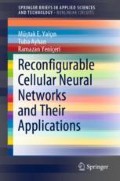Abstract
Performance of an artificial olfaction system depends on the success and speed of its classification according to the chosen problem. In this chapter, the feature extraction part just before the classification part is exploited to reach a better performance for artificial olfaction systems, and cellular nonlinear network-based feature extraction models are presented. For achieving the best performance for different problems on the same network, a reconfigurable cellular neural network is introduced as a feature extractor.
Access this chapter
Tax calculation will be finalised at checkout
Purchases are for personal use only
References
T.C. Pearce, S.S. Schiffman, Handbook of Machine Olfaction: Electronic Nose Technology (Wiley-VCH, 2003)
P. Nef, How we smell: the molecular and cellular bases of olfaction. News Physiol. Sci. 13, 1–5 (1998)
M. Zarzo, The sense of smell: molecular basis of odorant recognition. Biol. Rev. 82(3), 455–479 (2007)
L. Buck, R. Axel, A novel multigene family may encode odorant receptors—a molecular-basis for odor recognition. Cell 65(1), 175–187 (1991)
Q. Gao, B. Yuan, A. Chess, Convergent projections of Drosophila olfactory neurons to specific glomeruli in the antennal lobe. Nat. Neurosci. 3(8), 780–785 (2000)
A.F. Silbering, C.G. Galizia, Processing of odor mixtures in the Drosophila antennal lobe reveals both global inhibition and glomerulus-specific interactions. J. Neurosci. 27(44), 11966–11977 (2007)
B. Hansson, Olfaction in lepidoptera. Experientia 51(11), 1003–1027 (1995)
N. Strausfeld, L. Hansen, Y. Li, R. Gomez, K. Ito, Evolution, discovery, and interpretations of arthropod mushroom bodies. Learn. Mem. 5(1–2), 11–37 (1998)
W. Zhou, D. Chen, Binaral rivalry between the nostrils and in the cortex. Curr. Biol. 19(18), 1561–1565 (2009)
E. Morrison, R. Costanzo, Morphology of olfactory epithelium in humans and other vertebrates. Microsc. Res. Tech. 23(1), 49–61 (1992)
H. Hotelling, Analysis of a complex of statistical variables into principal components. J. Educ. Psychol. 24, 417–441 (1933)
C.E. Shannon, A mathematical theory of communication. Bell Syst. Tech. J. 27, 379–423 (1948)
A. Vergara, S. Vembu, T. Ayhan, M.A. Ryan, M.L. Homer, R. Huerta, Chemical gas sensor drift compensation using classifier ensembles. Sens. Actuators B Chem. 166167, 320–329 (2012)
Figaro USA, Inc., http://www.figaro.co.jp/en/. Accesssed 15 Feb 2019
A. Setkus, A. Olekas, D. Senuliene, M. Falasconi, M. Pardo, G. Sberveglieri, Featuring of odor by metal oxide sensor response to varying gas mixture, in Olfaction and Electronic Nose, Proceedings, of AIP Conference Proceedings, ed. by M. Pardo, G. Sberveglieri, vol. 1137 (2009), pp. 202–205
K. Pearson, On lines and planes of closest to systems of points in space. Philos. Mag. 2(6), 559–572 (1901)
V. Vapnik, The Nature of Statistical Learning Theory (Springer, N.Y., 1995)
S. Haykin, Neural Networks: A Comprehensive Foundation (Prentice Hall, 1998)
C.C. Chang, C.J. Lin, LIBSVM: a library for support vector machines, v2.85, software available at https://www.csie.ntu.edu.tw/~cjlin/libsvm/. Accessed 15 Feb 2019
M.K. Muezzinoglu, A. Vergara, R. Huerta, T. Nowotny, N. Rulkov, H.D.I. Abarbanel, A.I. Selverston, M.I. Rabinovich, Artificial olfactory brain for mixture identification, in NIPS ed by D. Koller, D. Schuurmans, Y. Bengio, L. Bottou, (MIT Press, 2009), pp. 1121–1128
T. Ayhan, K. Muezzinoglu, M.E. Yalcin, Cellular neural network based artificial antennal lobe, in Proceedings of the 12th IEEE International Workshop on Cellular Neural Networks and their Applications (CNNA 2010) (2010), pp. 1–6
T. Ayhan, M.E. Yalcin, An application of small-world cellular neural networks on odor classification. Int. J. Bifurc. Chaos 22(1), 1–12 (2012)
F. Gollas, C. Niederhoefer, R. Tetzlaff, Toward an autonomous platform for spatio-temporal EEG signal analysis based on cellular nonlinear networks. Int. J. Circuit Theory Appl. 36(10), 623–639 (2008)
S. Sanei, J. Chambers, EEG Signal Processing (Wiley-Interscience, 2007)
EMOTIV, http://www.emotiv.com/. Accessed 15 Feb 2019
Author information
Authors and Affiliations
Corresponding author
Rights and permissions
Copyright information
© 2020 The Author(s), under exclusive licence to Springer Nature Switzerland AG
About this chapter
Cite this chapter
Yalçın, M.E., Ayhan, T., Yeniçeri, R. (2020). Artificial Olfaction System. In: Reconfigurable Cellular Neural Networks and Their Applications. SpringerBriefs in Applied Sciences and Technology(). Springer, Cham. https://doi.org/10.1007/978-3-030-17840-6_3
Download citation
DOI: https://doi.org/10.1007/978-3-030-17840-6_3
Published:
Publisher Name: Springer, Cham
Print ISBN: 978-3-030-17839-0
Online ISBN: 978-3-030-17840-6
eBook Packages: Intelligent Technologies and RoboticsIntelligent Technologies and Robotics (R0)

